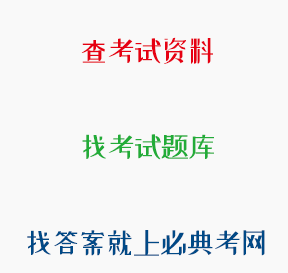正确答案: B
教书育人
题目:被称为"范跑跑"的中学教师范美忠认为"教师只是一种谋生的手段",却"被认为带上了神圣的光环"。范美忠的言论与下面的那一条职业道德规范相违背?()。
解析:《中小学教师职业道德规范》(2008修订)规定"教书育人"。教书育人是教师职业的天职和道德的核心。"范跑跑"只把教师职业作为一种谋生手段,没有真正做到教书育人。故选择B。
查看原题 查看所有试题
学习资料的答案和解析:
[单选题]《中华人民共和国教育法》最重要立法目的是( )。
为了发展教育事业,提高全民族的素质
解析:《中华人民共和国教育法》第一条规定:为了发展教育事业,提高全民族的素质,促进社会主义物质文明和精神文明建设,根据宪法,制定本法。故选择A。
[单选题]以下说法正确的是( )。
对无其他监护人的孤儿应由民政部门设立的儿童福利机构收留抚养
解析:《中华人民共和国未成年人保护法》第四十三条规定:对孤儿、无法查明其父母或者其他监护人的以及其他生活无着的未成年人,由民政部门设立的儿童福利机构收留抚养。故选择C。《中华人民共和国未成年人保护法》第六十七条规定:未成年人出售烟酒,或者没有在显著位置设置不向未成年人出售烟酒标志的,由主管部门责令改正,依法给予行政处罚。故A错误。《中华人民共和国未成年人保护法》第三十条规定:爱国主义教育基地、图书馆、青少年宫、儿童活动中心应当对未成年人免费开放:博物馆、纪念馆、科技馆、展览馆、美术馆、文化馆以及影剧院、体育场馆、动物园、公园等场所,应当按照有关规定对未成年人免费或者优惠开放。并非所有的公园都是对未成年人免费开放,故C错误。《中华人民共和国预防未成年人犯罪法》于1999年11月1日起施行;《中华人民共和国未成年人保护法》于2007年6月1日起施行。故D错误。
[单选题]把握问题的本质和关键信息,摒弃无关因素,并在头脑中形成有关问题的初步印象,即形成问题的表征的过程,就是( )。
明确问题
解析:问题解决的基本过程是发现问题一理解问题一提出假设一检验假设。理解问题就是把握问题的本质和关键信息,摒弃无关因素,并在头脑中形成有关问题的初步印象,即形成问题的表征。理解问题主要是确定问题究竟是什么,并尽可能地达到对整个问题的准确理解,即明确问题。
[单选题]下列属于内部动机的是( )。
喜欢听纯正的英语
解析:由个体内在需要引起的学习动机是内部学习动机,喜欢听纯正英语属于个体在的需要。A、B、D三个选项的学习分别是为了得到小红花、得到老师表扬、出国,都是由于外部诱因引起的,与外部奖励相联系属于外部学习动机。故选择C。
[单选题]学习策略一般包括认知策略、元认知策略和( )。
资源管理策略
解析:学习策略一般包括认知策略、元认知策略和资源管理策略。
[单选题] After the violent earthquake that shook Los Angeles in 1994, earthquake scientists had good news to report: The damage and death toll could have been much worse.
More than 60 people died in this earthquake. By comparison, an earthquake of similar intensity that shook America in 1988 claimed 25,000 victims.
Injuries and deaths were relatively less in Los Angeles because the quake occurred at 4:31 am on a holiday, when traffic was light on the city's highways. In addition, changes made to the construction codes in Los Angeles during the last 20 years have strengthened the city's buildings and highways, making them more resistant to quakes.
Despite the good news, civil engineers aren't resting on their successes. Pinned to their drawing boards are blueprints for improved quake resistant buildings. The new designs should offer even greater security to cities where earthquakes often take place.
In the past, making structures quake-resistant meant firm yet flexible materials, such as steel and wood, that bend without breaking. Later, people tried to lift a building off its foundation, and insert rubber and steel between the building and its foundation to reduce the impact of ground vibrations, The most recent designs give buildings brains as well as concrete and steel supports. Called smart buildings, the structures respond like living organisms to an earthquake's vibrations. When the ground shakes and the building tips forward, the computer would force the building to shift in the opposite direction.
The new smart structures could be very expensive to build. However, they would save many lives and would be less likely to be damaged during earthquakes.
The author's main purpose in writing the Passage is to ________.
report new developments in constructing quake-resistant buildings
解析:1.细节题。根据短文第三段第二句“…changes made to the construction codes in Los Angeles during the last 20 years have strengthened the city's buildings and highways, making them more resistant to quakes.”可知是因为建筑法规在20年内的改变,使地震中的伤亡人数相对不高。故选项D正确。
2.细节题。根据短文第五段最后一句“When the ground shakes and the building tips forward,the computer would force the building to shift in the opposite direction.”可知当地面晃动,建筑物向前倾斜时,电脑会迫使它向相反的方向改变,从而保持平衡。故选项A正确。
3.细节题。文章最后一段指出“The new smart structures could be very expensive to build. However,they would save many lives and would be less likely to be damaged during earthquakes.”可知这种新型的智能结构虽然昂贵但是很值得建造。选项A、C文中没有提到,选项D的表述与原文不一致.故选项B正确。
4.推断题。根据短文第五段可知,过去人们认为建筑材料对减少地震损失很重要,但那是以前的方法,排除选项A、B。而现在重点强调的办法是减少地面震动。选项D文章没有提及,故选C。
5.主旨题。纵观短文可看出作者是通过描述发生在洛杉矶的地震来指出抗震技术的提高。选项A是说地震结果的比较,不是文章重点,选项B、C与原文表述不符,故选项D正确。
[单选题]请阅读 Passage 2,完成 1~5小题。
Passage 2
Scientists have been surprised at how deeply culture-the language we speak,the values we absorb-shapes the brain,and are rethinking findings derived from studies of Westerners.To take one recent example,a region behind the forehead called the medial prefrontal cortex supposedly represents the self: it is active when we ( "we" being the Americans in the study) think of our own identity and traits.But with Chinese volunteers,the results were strikingly different.The "me" circuit hummed not only when they thought whether a particular adjective described themselves,but also when they considered whether it described their mother.The Westerners showed no such overlap between self and mom.Depending whether one lives in a culture that views the self as autonomous and unique or as connected to and part of a larger whole,this neural circuit takes on quite different functions.
"Cultural neuroscience" ,as this new field is calleD.is about discovering such differences.Some of the findings,as with the "me/mom" circuit,buttress longstanding notions of cultural differences.For instance,it is a cultural cliche that Westerners focus on individual objects while East Asians pay attention to context and background (another manifestation of the individualism-collectivism split).Sure enough,when shown complex,busy scenes,Asian-Americans and non-Asian-Americans recruited different brain regions.The Asians showed more activity in areas that process figure-ground relations-holistic context-while the Americans showed more activity in regions that recognize objects.
Psychologist Nalini Ambady of Tufts found something similar when she and colleagues showed drawings of people in a submissive pose (head down,shoulders hunched) or a dominant one (arms crosseD.face forward) to Japanese and Americans.The brain's dopamine-fueled reward circuit became most active at the sight of the stance-dominant for Americans,submissive for Japanese-that each volunteer's culture most values,they reported in 2009.This raises an obvious chicken-and-egg question,but the smart money is on culture shaping the brain,not vice versa.Cultural neuroscience wouldn't be making waves if it found neurobiological bases only for well-known cultural differences.It is also uncovering the unexpected.For instance,a 2006 study found that native Chinese speakers use a different region of the brain to do simple arithmetic (3 + 4) or decide which number is larger than native English speakers do,even though both use Arabic numerals.The Chinese use the circuits that process visual and spatial information and plan movements (the latter may be related to the use of the abacus).But English speakers use language circuits.It is as if the West conceives numbers as just words,but the East imbues them with symboliC.spatial freight.(Insert cliche about Asian math geniuses.) "One would think that neural processes involvng basic mathematical computations are universal," says Ambady,but they "seem to be culture-specific".
Not to be the skunk at this party,but I thunk it's important to ask whether neuroscience reveals anything more than we already know from,say,anthropology.For instance,it's well known that East Asian cultures prize the collective over the individual,and that Americans do the opposite.Does identifying brain correlates of those values offer any extra insight? After all,it's not as if anyone thought those values are the result of something in the liver.
Ambady thinks cultural neuro-science does advance understanding.Take the me/mom finding,which,she argues,"attests to the strength of the overlap between self and people close to you in collectivistic cultures and the separation in individualistic cultures.It is important to push the analysis to the level of the brain." Especially when it shows how fundamental cultural differences are-so fundamental,perhaps,that "universal" notions such as human rights,democracy,and the like may be no such thing.
Which of the following can be inferred from the passage?
The brain is believed to be influenced by different cultures.
解析:推断题。文章首段第一句说“Scientists have been surprised at how deeply culture…shapes the brain”,结合下文讲述的文化神经科学的研究,可推出大脑(神经)受文化的影响,故本题选B。C项本身表述正确,但不是推断出的内容,它可以从原文第二段第三句直接得出。

 川公网安备 51012202001360号
川公网安备 51012202001360号